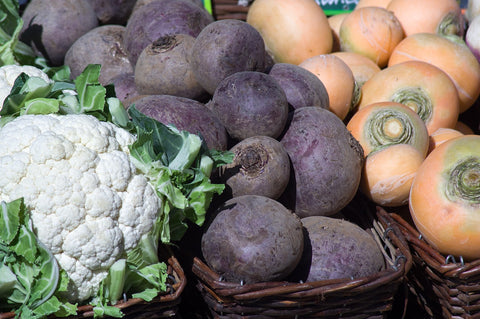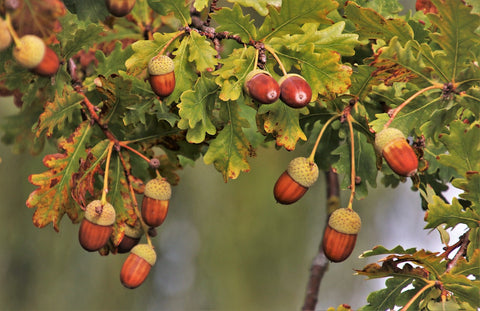How and when is the best time to aerate and seed your lawn? Does it matter the type of grass seed I use to overseed my lawn? This blog will address some of the questions we get on good seeding practices for successfully improving your lawn including the value of aerating, what to look for in grass seed and seeding rates.
Mechanical aeration alleviates soil compaction in established turf. Compaction occurs primarily in the soil surface. A compacted layer as thin as one-fourth to one-half an inch can greatly impede water infiltration and gas exchange between soil and the atmosphere. Heavy soils with clay, little topsoil or compaction will benefit greatly with aeration. In addition, if you plan to overseed your lawn to fill in bare patches, aeration at seeding time will give greater germination results since seed needs good soil contact.
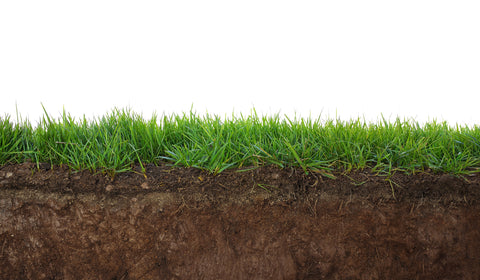
Aeration also:
-
Encourages root growth by increasing oxygen to roots
-
Allows seed, lime, and fertilizer to enter the soil instead of running off
-
Allows for incorporation of new improved varieties of seed into the existing lawn
Aerating machines should remove plugs of soil from the turf, creating a system of large pores for moisture and plant nutrients to be taken into the soil. They are referred to as core aerators. Core aerators pull plugs about ½- to ¾-inch in diameter, 2 to 4 inches deep, and about 2 to 6 inches apart. Equipment having solid tines or spikes should not be mistaken for aerating equipment.
-
Fall is the best time to aerate cool-season grasses.
-
June through July is the recommended time to aerate warm-season varieties.
-
Never aerate when a lawn is dormant.
-
A general rule is to aerate only when desirable grasses are growing vigorously. For the mid-Atlantic area March-May and Sept-Oct are best.
-
Soil should be moist, not wet, before aerating. Irrigate the lawn prior to aerating if the soil is compacted or very dry.
-
Aeration can be done while or before overseeding. This procedure makes holes for the seed to fall into increasing seed-to-soil contact.
-
Core aeration should be performed every year on lawns that receive heavy foot traffic. Otherwise, aerating every other year on home lawns is sufficient.
-
The equipment you use makes a difference. Select a heavy aerator with over 5 HP to create cores of 3” to 4”. Rental stores usually have good machines to rent. Traverse the lawn slowly to allow effective penetrations instead of bumping over the surface. Ensure there is enough soil moisture to encourage solid cores to be pulled as well. Lawn contractors typically have good heavy equipment that can often seed at the same time as aerating.
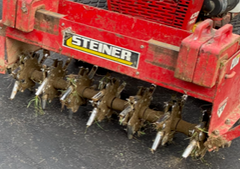
-
Soil plugs can be left on the surface of the grass. They will decompose in a couple of weeks.
-
Aerifying in the fall (late August to late October) provides more oxygen to the roots and protected holes for new seeds to germinate and establish solid roots before freezing. Fall is a time with less weed competition, so it is ideal for establishing new seedlings.
-
If you have substantial areas of dead grass, crabgrass, or weeds, it is probably more effective to remove the dead grass and leaves with a hard rake, a “power rake”, or a de-thatcher to improve seed-soil contact. By seeding into an area with dead debris, the seed may germinate and then dry out or not thrive due to restricted roots.
-
Select quality “turf-type” tall fescue seed. The University of Maryland publishes a list of Maryland-adapted turfgrass cultivars in publication TT-77. The Mill grass seed blends are MD-recommended, improved varieties that are blue tag certified with NO fillers. These varieties may be a little more expensive than economy grass seed with fillers at big-box stores, but they are worth the investment since they exhibit better quality, density, disease tolerance, and persistency over the years. See the example below for seed purity.
-
Seeding rate is important. Use a drop spreader or rotary spreader to spread the seed evenly over the area to be planted. For a complete renovation of lawns, plan for 5-7 lbs. of seed per 1000 sq. ft. For rejuvenation of existing lawns, use 3-5 lbs. per 1000 sq. ft.
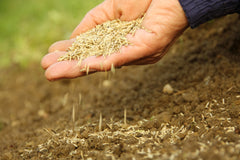
When fall overseeding, use a good starter fertilizer with slow-release nitrogen. The University of Maryland Extension recommendation for tall fescue lawns is to apply 0.9 lb. nitrogen/1000 sq. ft. Keep in mind, Maryland has fertilizer laws against adding phosphorous (i.e. the middle number on a bag of fertilizer should be “zero”) unless you are doing a complete lawn renovation or have a soil test result that indicates phosphorus is needed.
Pay attention to Seed Purity. Many brands of grass seed have less seed and coverage than what they market. Learn to read the label. When comparing labels, look at the % of seed varieties and especially the “other” ingredients to determine quality.
Look for these red flags:
- Coating Material
- Inert Material
What exactly are these materials?
Coating material is just fertilizer. Many big-box store grass seed brands pitch that this “coating material” helps your seed grow. This may or may not be the case, but at a minimum, the bag of “seed” you are buying is not predominantly the seed itself which is very important when you are calculating the true cost of what you are buying on a per seed basis.
Inert Material is sawdust. Why do you need sawdust in a bag of grass seed? You don’t. It’s just there as filler and materially dilutes the value of your purchase.
When you pick up a bag of big-box grass seed, you’ve been misled as to the true value of your purchase. You might even think that it’s okay to have some of this filler in your bag. But we’re not talking about 1-2% filler. The truth is many big-box grass seed brands often sell you as much as 80-90% filler. We’re not kidding. Here’s a look at a real-life label that we snapped from a national big-box store just down the road from us:
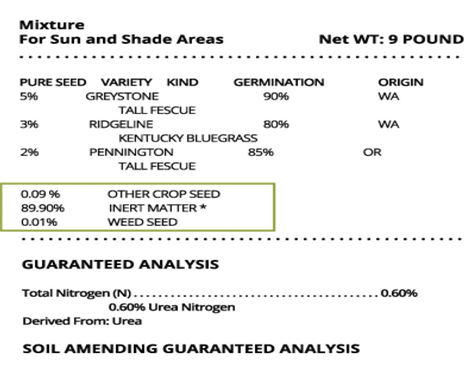
What do you notice?
This 8.3-pound bag of seed is only 10% grass seed. You’re paying $20+ for sawdust and fertilizer which is much less expensive to buy separately than in the seed bag. And while this is a somewhat extreme example, it’s still common practice to add unnecessary elements to bag seeds. Most big-box brands only use 50% grass seed.
At The Mill we only carry and stock pure seed - NO filler and NO coatings!



